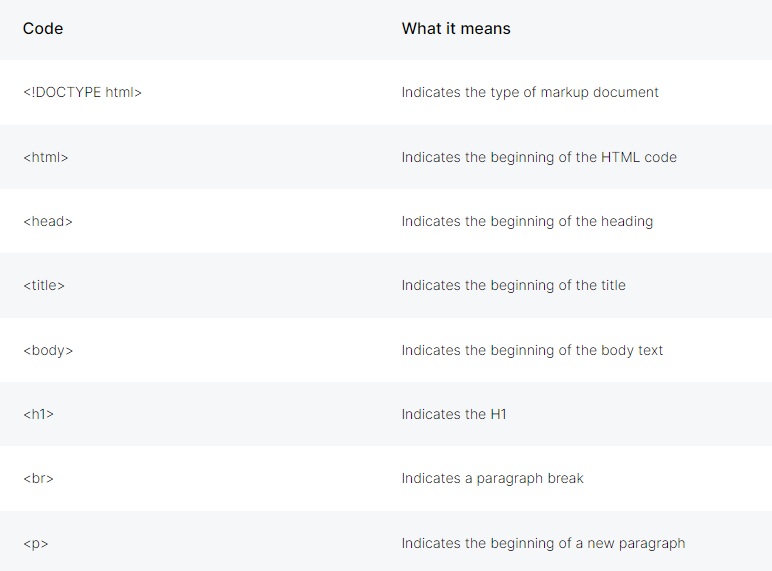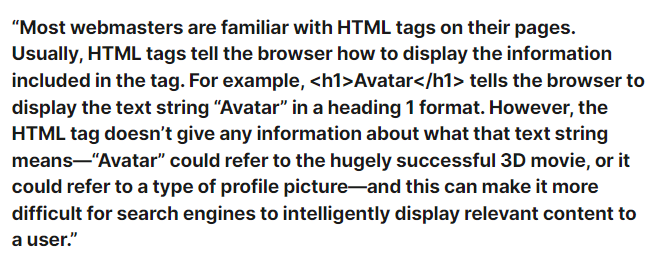Markup Language: What Is It and Why Should You Care?
It is used to define the fundamental elements of a document to be displayed on your computer screen, whether that’s HTML, XML, or any other format you can think of.
They serve as the instructions that tell your computer what information should be displayed on your screen and how it should be organized and formatted.
While your choice of markup language will not impact SEO directly, certain types of markup make it easier for search engines to understand the content of a page.
So, let’s get more into that…
What Are Markup Languages?
Markup language definition: A markup language is a system for annotating a document in a way that is syntactically distinguishable from the text.
In other words, it’s a way to add information to a document.
This extra information can be anything from comments to formatting instructions.
Is it a programming language?
Nope.
Regarding markup language vs programming language, the former is not executed: they are read and rendered instead.
In contrast to a programming language, a markup language has no computational power.
HTML, which stands for HyperText Markup Language, is perhaps the best-known markup language.

Other examples of markup languages include XHTML, which stands for eXtensible Hypertext Markup Language, SGML, and XML.
Markup languages are designed to store information about a document’s structure and presentation rather than its content.
Another basic characteristic is that markup language is invisible to a web page or document reader since the only way to view it is by accessing the source code.
How Does It Work
In order to format or structure a page, markup language uses a series of tags whose symbol is <>.
These tags act like instructions, and enclosing them in angle brackets (<>) makes the tags syntactically different from plain text.
Text within these brackets is considered to be a part of the markup language.
The text outside it is an annotated text.
Markup tags are read and interpreted, generating output, usually as a page formatted and styled accordingly while keeping the actual markup hidden from plain sight.
For example, in HTML markup language, the H1 tag indicates that that is your web page’s main header, and these tags instruct the machine to render that header in a bolder or larger font.
As per the standard HTML conventions.
This means that the page reader would only see the formatted header instead of the markup tags.

What Types of Markup Languages Are There?
Some languages were mentioned before in the article.
However, nearly every acronym on the Web that has ‘ML’ in it is a ‘markup language’ used to create web pages.
There are 8 lists of markup languages: XML, HTML, general purpose markups, document ones, lightweight markups, and others.
You’ve likely run across HTML, XML, and XHTML so far.
ML is a general notion that describes the language, annotating text, and how the PC can manipulate it.
Markup Languages and Their Importance to SEO
Markup Languages Make It Easier for Search Engines to Understand the Content of a Page
Search engines and other web crawlers have difficulty parsing the markup of websites.
This is due to the fact that they don’t understand the language that web pages are written in.
Markup languages, such as HTML5 and XHTML, make it easier for search engines to understand the content of a page by using tags and attributes to describe important elements such as headings and paragraphs.
This makes it much easier for crawlers like Googlebot to find relevant content on your site and determine whether or not it is worth ranking.
Markup Languages Allow Google to Display Rich Snippets on the Search Results Page
It allows Google to display rich snippets on the search results page.
These rich snippets include detailed information about the page, as well as a preview of the content.
Rich snippets are a great way for businesses to better describe their products and services, as well as their brand identity.
These pages can also be used for SEO purposes by providing relevant information about a company’s services or products.
Conclusion
You may have never heard of a markup language if you’re not a programmer.
It is a set of code that helps structure text or add information to it.
This code can be used to format text, add images, create links, and more.
But not only programmers should be in the know regarding the importance of markup languages.
Understanding Structured Data, Markup Language, and Schema.org will help you easily improve your website ranking.
After all, it is essential to make the content of your website easy for Google to understand, especially if you want it to be correctly displayed and distributed in SERP.





